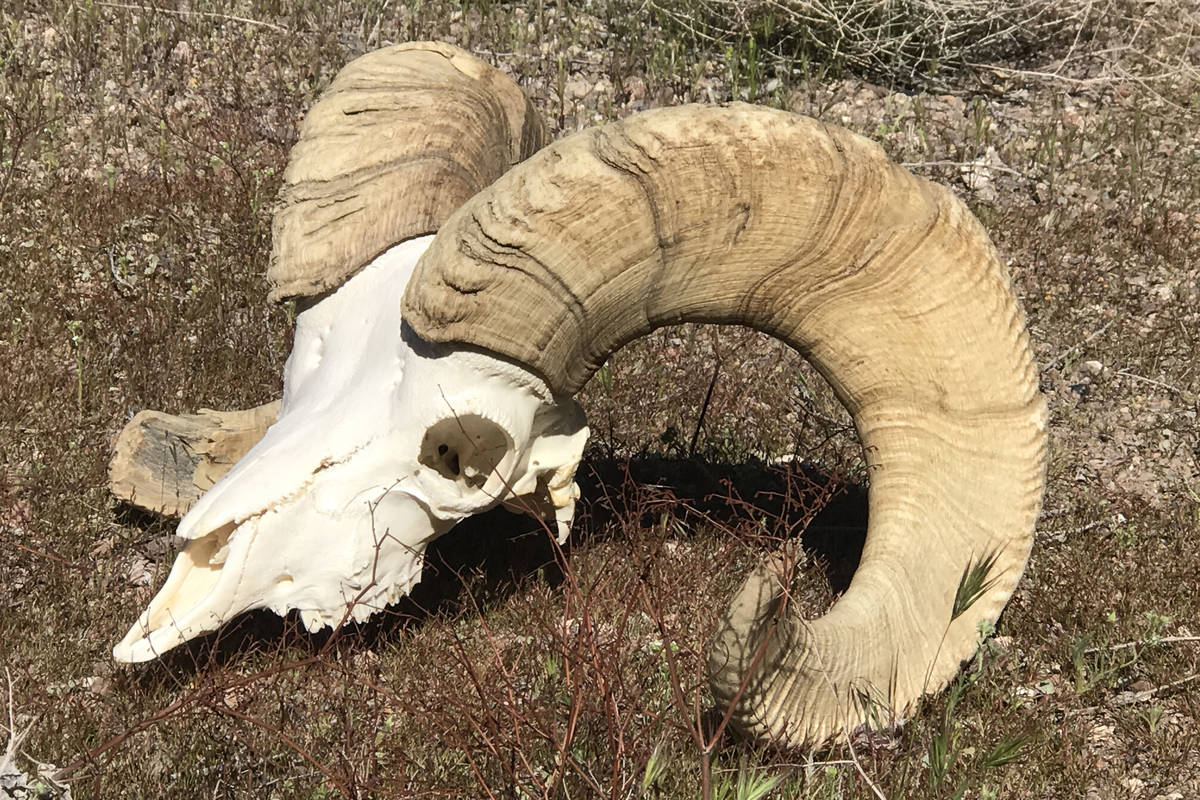Preserving animal’s skull is an easy, inexpensive project
The side by side bounced off the rocks as we made our way down one of Southern Nevada’s typical “dirt” roads. One that is half-wash, half-packed gravel and salted with rocks just big enough to bounce you off the seat if you are not paying attention. Sometimes even when you are.
It was the weekend before Thanksgiving 2018, and Jed Topham and I were scouting for a bighorn sheep hunt. As we stopped to glass the rocky slopes around us, I noticed a white spot gleaming brightly near the opening of a shallow cave partway up the hill to the east of us. It was late in the afternoon, and the sun acted like a spotlight on whatever it was that lay there.
Through my binoculars, it took only a second to recognize the curving bony core over which a bighorn ram’s keratin horn sheaths once grew. Unlike members of the deer family, which cast off and regrow their antlers each year, a bighorn sheep has a true horn that grows continuously throughout the animal’s life. So, such a find is rare.
Jed volunteered to climb up to the skull, and he found the remains of a dandy ram. It had been dead long enough that the horn sheaths had been separated from the skull by critters scavenging for a meal. We had happened upon a treasure.
We documented the find, and after my sheep hunt was over, obtained the required paperwork from state game wardens that allowed us to pick up the skull. Then came the question, “What now?”
The services of a taxidermist were an option, but I wanted to do something on my own. Looking for options, I happened upon a document produced by the University of Arizona Cooperative Extension titled “Cleaning and Preserving Animal Skulls.” The document provides instructions for processing animal skulls in various states from fresh and flesh-covered to sun dried and picked nearly clean.
The first step is always to remove all soft tissue. Since my sheep skull was already nearly free of all soft tissue and had dried in the sun, I opted to bleach, or whiten, the skull by soaking it in hydrogen peroxide. Despite being referred to as bleaching, the process does not involve chlorine bleach because the chemical can dissolve the bone tissue you want to preserve.
Bleaching directions call for soaking the skull in a 3 to 6 percent solution of hydrogen peroxide. Be prepared for the looks you will get when you show up at the cashier with enough hydrogen peroxide to fill a mop bucket.
The benefits of this process are removal of small pieces of stubborn tissue and debris from inside the skull and, most important, much of any existing odor. Precautions should be taken to make sure you do not get any hydrogen peroxide in your eyes.
After placing the skull in a bucket, I filled it with enough hydrogen peroxide to cover it and much of the bony horn cores. And as someone familiar with hydrogen peroxide might expect, tiny bubbles immediately started floating from the skull to the solution’s surface.
According to the directions, “The time required to bleach the skull will vary with species and the whiteness desired. When using hydrogen peroxide, most of the bleaching process will have been completed when the solution stops bubbling. After the skull is bleached to the desired whiteness, it should be rinsed with water and allowed to dry completely.”
Ten days after placing the skull in the hydrogen peroxide, I pulled it from the solution. There was still some bubbling, but the skull was clean of soft tissue and any odor. It also was white. Anything more would not have looked natural. I rinsed the skull with water and let it dry.
To keep the teeth from falling out, I set them in place with clear drying glue and then finished the project by spraying the skull with light layers of clear polyurethane to preserve the skull.
This is an easy and inexpensive project to complete. The instructions can be found at extension.arizona.edu/sites/extension.arizona.edu/files/pubs/az1144.pdf.
Freelance writer Doug Nielsen is a conservation educator for the Nevada Department of Wildlife. His “In the Outdoors” column is not affiliated with or endorsed by the NDOW. Any opinions are his own. Find him on Facebook at @dougwritesoutdoors. He can be reached at intheoutdoorslv@gmail.com


















